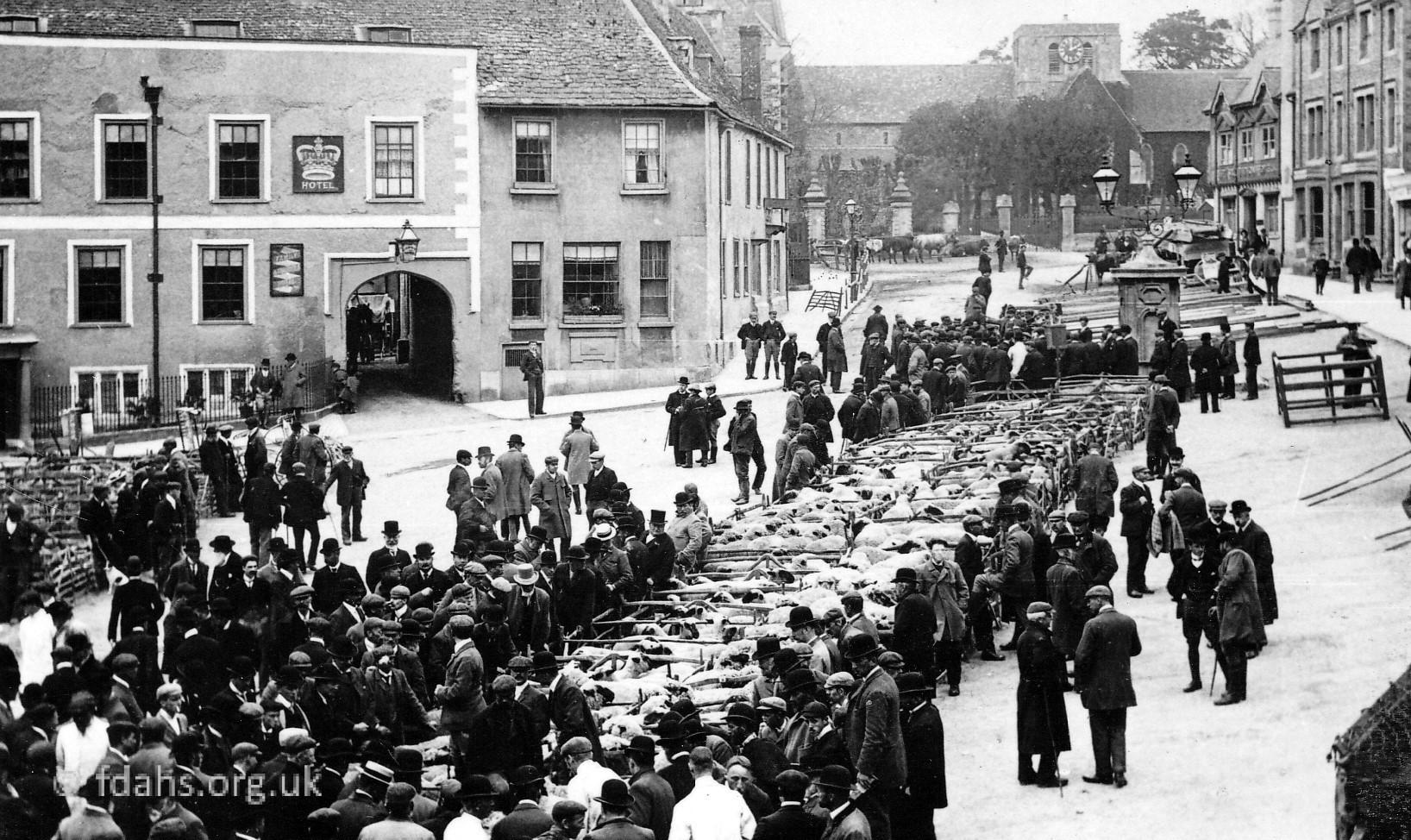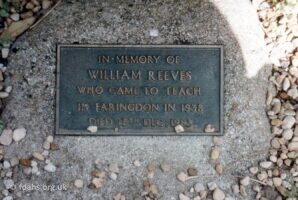The Landed Gentry
People of the British aristocracy, of whom a great deal has already been recorded elsewhere, but had to be included on this website as they lived and raised their families here, and formed a significant part of the history of Faringdon and district.
For more information on these or any other more widely famous people of Faringdon, then you might start with this page on the Faringdon Community Website or do a general search of the internet.
Some Commoners
Here are some of the common people who played a small but notable part in the local community and helped to make Faringdon what it has become today. Others may be mentioned elsewhere on this website and can be found by using the search facility in the menu above. For example George Frederick Crowdy, a very significant person of his time, appears on pages: Wars of the 1800s, Enforcing the Law, and the Faringdon Railway.
Carter & Sons (Marlborough Street grocers since 1848)
The Carter family had been associated with the grocery business through 5 generations in Faringdon since 1848. Previous generations living in the 1700s were tenant farmers coming from the nearby villages of Watchfield and later from Littleworth. One of whom, a Thomas Carter (1789-1861) was a soldier in the Napoleonic Wars where he was wounded and taken prisoner in the Battle of Bayonne.
John Carter (1813-1867) married to Elizabeth Dubber. John became joint owner of the grocery & provision business at 3 Marlborough Street in 1848. He became sole owner in the early 1860’s.
His son, also named John Carter (1838-1903) and married to Ruth Wheeler joined his father John (senior) in the shop in the 1850’s.
His son, Albert Carter (1869-1925) and married to Mary Ellen Coles joined his father John (junior) in the shop in the 1890’s.
His son, Cyril John Carter (1902-1970), with his sisters Kathleen and Phyllis, took control of the the grocery store when their father Albert died in 1925. At that time they also opened a café within the shop. When Cyril got married to May Clark five years later, the sisters left to take over Lay’s bakery shop at 9 Market Place, next to Lloyds Bank. They also opened a café to replace the one in Marlborough Street. In 1932 Cyril and May had a daughter Ruth, followed by June in 1935, John in 1937 and Norman in 1938.
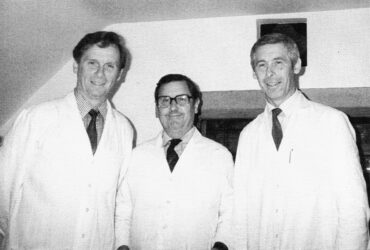
John joined the firm when he left school in 1953 and then brother Norman joined in 1959. When Cyril became ill in 1959, they both assumed control of the business together with their mother May. In the same year they purchased the butcher’s business of H.Taylor & Sons at 6 Cornmarket and John managed that side of the affairs. In 1962 the main shop was given a face lift and in 1965 was made into a self-service store. The shop was further enlarged in 1966/67. In 1972, the Carter brothers purchased the garden of the Red Lion public house, again enlarging the floor space of the store, and gaining access to the town car park in Southampton Street (which caused much controversy). In 1975 the centre of the store and the warehouse were demolished and rebuilt, thus expanding the store to 7,500 sq. ft. In the years that followed John and Norman purchased both Nos. 5 and 7 Marlborough Street, and the store was enlarged yet again. In 1986 Carter’s was one of the first grocery shops in the United Kingdom to use scanning at the exit tills. In the following year the remainder of 5 Marlborough Street was incorporated into the store as a new wine department.
In 1996 the Carter brothers sold the store to Budgens who finally closed it down completely in 2018. The premises still remain empty in 2023.
References:
- The Changing Faces of Faringdon and Surrounding Villages – Book 1 p62. By Rosemary Church, Jim Brown, Millie Bryan and Beryl Newman. Robert Boyd Publications 1999 – now out of print.
- Rotary Job Talk 7th October 1998 and other personal documents provided by John Carter, who now lives in Shrivenham.
George Frederick Crowdy (1819-1895)
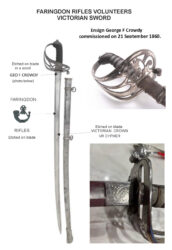 This Victorian sword, engraved ‘Faringdon Rifles’ belonged to Ensign George Frederick Crowdy (1819-1895), who was born and raised in Faringdon. He was commissioned on 21 September 1860 at the age of 41. Before joining the Faringdon Rifles Volunteers he was already a citizen of high standing – a solicitor, clerk to the magistrates, registrar of county court, commissioner to administer oaths in chancery, perpetual commissioner and agent to the Sun Fire and Life Insurance.
This Victorian sword, engraved ‘Faringdon Rifles’ belonged to Ensign George Frederick Crowdy (1819-1895), who was born and raised in Faringdon. He was commissioned on 21 September 1860 at the age of 41. Before joining the Faringdon Rifles Volunteers he was already a citizen of high standing – a solicitor, clerk to the magistrates, registrar of county court, commissioner to administer oaths in chancery, perpetual commissioner and agent to the Sun Fire and Life Insurance.
He was also one of a group of prominent local men and their supporters who, acting on their own initiative, set up the Faringdon Railway Company in 1860, and built their own 3½ mile Faringdon Railway extension from the GWR line at Uffington.
Mr Crowdy had Grove House, near the end of Church Street, built for himself and family together with a coach house and stables next door. Around 1890, the very old shops on the corner opposite the church were demolished and replaced with an extension to the existing Salutation Hotel and a grand new building for Crowdy & Son (solicitors) next door. George died soon after in January 1895 at about age 76 and was buried at All Saints Church.
References:
- Ensign George Frederick Crowdy’s sword, currently owned and information provided by John Last of Oxford, collector of militaria for Oxfordshire.
- Directory & Gazetteer of Oxon, Berks & Bucks – Dutton, Allen & Co 1863.
Jonathan Goddard (1834-1917)
Jonathan Goddard, a Victorian self-made businessman (in drapery and haberdashery) and who played a leading role in building the Methodist Church on Coxwell Street (now the United Church).
Jonathan was born in Stanford-in-the-Vale in 1834, to a family of agricultural labourers. As a teenager, Jonathan went to work at the brick kilns with his father, and then became an apprentice shoemaker in Cricklade. Here he appears to have courted, and then married, Maria Stone who was two years his senior – and the daughter of his master.
In 1858 Maria gave birth to their first son, James, and they then moved to a cottage in Coxwell Street, Faringdon. Just opposite was the new Primitive Methodist Chapel, and Jonathan joined with enthusiasm, becoming in that year a lay preacher, Sunday School teacher, and steward. More children followed rapidly – Albert, Hannah, Jonathan Jr, and Tryphena. He must have been doing well because the family moved to what is now No. 11 Gloucester Street and in 1871 they had taken in Jonathan’s brother and sister as lodgers (and possibly employees).
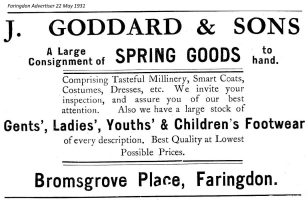 Around 1882 Jonathan bought a draper’s business in Faringdon – one of many at that time – following the death of its owner Mr Edgar Goulding. This shop was known as “Goulding Goddards” well into the 1960s and is now part of the Betfred frontage at No. 10 Marlborough Street. Then in the 1890s Jonathan expanded his empire by buying Mr William Sell’s haberdashers in Bromsgrove. It was known as “Top Goddards” until it closed in the 1970s and was converted into a restaurant. It is now the Grade II listed “La Bobina” restaurant, with the haberdashery fittings from Jonathan Goddard’s time still in place.
Around 1882 Jonathan bought a draper’s business in Faringdon – one of many at that time – following the death of its owner Mr Edgar Goulding. This shop was known as “Goulding Goddards” well into the 1960s and is now part of the Betfred frontage at No. 10 Marlborough Street. Then in the 1890s Jonathan expanded his empire by buying Mr William Sell’s haberdashers in Bromsgrove. It was known as “Top Goddards” until it closed in the 1970s and was converted into a restaurant. It is now the Grade II listed “La Bobina” restaurant, with the haberdashery fittings from Jonathan Goddard’s time still in place.
By 1897 the Primitive Methodists had outgrown their little chapel and it was sold to the Anglicans as a Mission Hall (you can still see the plaque on the gable end). To replace it, the United Reformed Church, the redbrick building you see today on the corner of Coxwell Street and Gravel Walk was built and six foundation stones (one bears Maria’s name) placed at the front.
Jonathan died in 1917 and his son Albert took over the shop with his wife Nancy. It subsequently passed through the hands of other family members but retained the name “J. Goddard and Sons”. He is buried with Maria in the Free Church Cemetery in Canada Lane and a plaque commemorating his church life was erected after his death, possibly at the same time as the war memorial.
Reference:
Adapted from an article written for the Faringdon Folly newspaper by local resident Dave Headey 2017.
Henry Lay (1815-1879)
Henry Lay was born on the 18th September 1815 in Highworth, Wiltshire. By the age of 25, Henry had moved to London Street, Faringdon where his occupation was listed as a confectioner. In 1842, Henry married Eliza Judd.
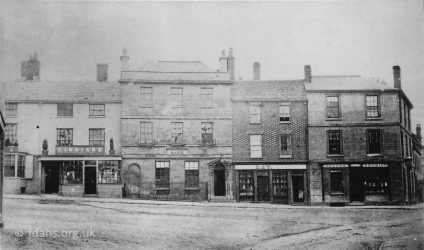 The first time we see Henry and Eliza in 9 Market Place (bakers & confectioners) is in the 1861 Census.
The first time we see Henry and Eliza in 9 Market Place (bakers & confectioners) is in the 1861 Census.
In 1873, Henry purchased a property in Wood Street, Swindon. His son Albert George took over that business upon the death of his father in 1879, although Henry’s widow Eliza continued as the main force in the premises.
The 1881 Census for 9 Market Place shows Henry and Eliza’s daughter Emily Lay as Head of the Household along with Margaret Sophia Lay, a Confectioners Daughter, Jess Maria Lay, a Confectioners Daughter, Sarah Ann Davis (sister of Henry Lay) and George Stafford Willis, a Pastry Cook.
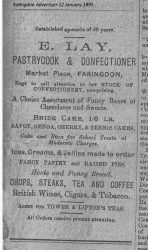 The 1891 Census for 9 Market Place, shows Eliza has returned to the Faringdon premises as owner and confectioner. On the premises are son in law George Stafford Willis, a Confectioner born in Malta who is married to Henry and Eliza’s daughter Eliza Emily. Henry and Eliza’s daughter Margaret Sophia, a Confectioner and Mary Rodgers, a general domestic servant born in Seven Bridges, Wiltshire.
The 1891 Census for 9 Market Place, shows Eliza has returned to the Faringdon premises as owner and confectioner. On the premises are son in law George Stafford Willis, a Confectioner born in Malta who is married to Henry and Eliza’s daughter Eliza Emily. Henry and Eliza’s daughter Margaret Sophia, a Confectioner and Mary Rodgers, a general domestic servant born in Seven Bridges, Wiltshire.
Eliza died in 1897 at the age of 75. The 1901 and 1911 Census for 9 Market Place shows George Stafford Willis now as Head of the household with wife Eliza Emily, and sons Gilbert John and Cecil George. George is listed as a Confectioner. In 1930, George sold the business to Kathleen & Phyllis Carter of Carter’s Supermarket in Marlborough Street.
Reference:
A document sent by Paul Newman whose mother’s family is Lay – henry-lay-9-market-place.pdf
George Earnest Liddiard (1860-1935) & Frank Hazel Liddiard (1867-1954)
The Liddiard family owned a lot of land near the end of Southampton Street. Possibly purchased by George J P Liddiard (1828-1919) who was born in Aldbourne, Wiltshire.
George is registered as a grocer in Market Place, Faringdon in the 1861-91 census and as retired by 1911. He married Eliza Ann Lewis from Wantage in 1858 and then Martha Sophia Habgood from Witney in 1884. George and Eliza’s two surviving sons are mentioned here from their known involvement in the local community.
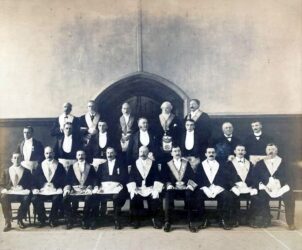
1910. Frank Hazel Liddiard, Master of the Masonic Lodge, is centre front in this photo. He was a prominent business man (grocer) in Faringdon who lived at “The Lindens” (now known as Linden House at 20 Market Place).
Since the late 19th century until about 1972, the Liddiard family owned a grocery, wholesale tobacconist and general store at 7 Market Place (next to what was Lloyds Bank).
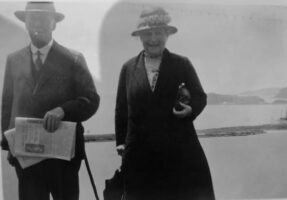
Frank split from his father George JP and elder brother George Ernest and set up his own business. He became a grocer and provisions dealer in the shop right next door to his house at no.21 until he retired in the 1920s, when the shop was taken over by International Stores.
There is a row of old cottages heading off Southampton Street, called Liddiard’s Row that were built around the turn of the century, presumably by the family. In 1915, Frank’s brother, George Ernest Liddiard donated some land on the other side of the street to the Tennis Club. In 1918, he also purchased an orchard off Gravel Walk to give to the Bowling Club. Frank Liddiard also had strong connections with the Bowling Club during his lifetime. He won various competitions and was the club president up to his death in 1954.
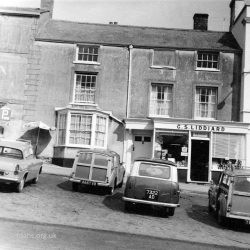 George Ernest continued to run the grocer shop at 7 Market Place until his eldest son, George Stanley Liddiard (1883-1959) took it over. The shop continued under the name G.S. Liddiard until around 1972.
George Ernest continued to run the grocer shop at 7 Market Place until his eldest son, George Stanley Liddiard (1883-1959) took it over. The shop continued under the name G.S. Liddiard until around 1972.
References:
- History & News – George Liddiard – https://www.historyandnews.co.uk/webtrees/individual.php?pid=I3525&ged=webgreen4.GED
- Document received from Frank’s granddaughter, Bridget Evans, dated May 2022 – frank-hazell-liddiard.pdf
Henry (1854-1930) and Sarah Proctor (1868-1940)
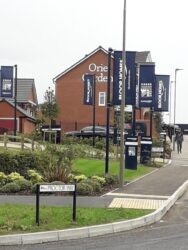 2021. The first road on the new Oriel Gardens estate, off Park Road, is named Proctor Way, after both James Proctor who died at Gallipoli in 1915, and his younger brother, Major Percival Proctor who died in Sudan in 1941 and whose name is also on the Khartoum War memorial as well as the one in Faringdon. But the road name could equally serve as a memorial to their parents Henry and Sarah Proctor, who deserve to be remembered as two of the great characters who left their mark on the town.
2021. The first road on the new Oriel Gardens estate, off Park Road, is named Proctor Way, after both James Proctor who died at Gallipoli in 1915, and his younger brother, Major Percival Proctor who died in Sudan in 1941 and whose name is also on the Khartoum War memorial as well as the one in Faringdon. But the road name could equally serve as a memorial to their parents Henry and Sarah Proctor, who deserve to be remembered as two of the great characters who left their mark on the town.
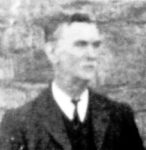 Henry Proctor was born in northern Lancashire, trained as a teacher and worked at an elementary school in Liverpool. In 1892, at the age of 38, he was widowed and left with two daughters. Later the same year he married Sarah Postlethwaite, fourteen years his junior and quite possibly a teaching colleague and two more children (James and Alice) arrived.
Henry Proctor was born in northern Lancashire, trained as a teacher and worked at an elementary school in Liverpool. In 1892, at the age of 38, he was widowed and left with two daughters. Later the same year he married Sarah Postlethwaite, fourteen years his junior and quite possibly a teaching colleague and two more children (James and Alice) arrived.
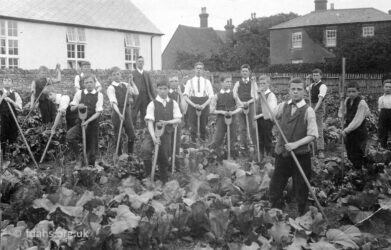
In 1898 the family moved to Faringdon to become headmaster and headmistress of what was then called the ‘British School’ in Canada Lane. Baby Percival arrived the following year. They lived (I think) in the fifth or sixth house down Gravel Walk on the left, opposite Westbrook House.
Pay was so bad that the Proctors also taught in night-school to make ends meet (presumably the older daughters babysat the younger three) and were founder members of the National Union of Teachers. Any spare time they may have had was spent organising scouts, guides, dancing, gardening* and concerts. Oh, and a sixth child, Stella, was born in 1909. Henry was in charge of First Aid for the district and trained nurses who went to France in WW1. Sadly in 1915 tragedy struck: within a month of James’ death in action, the Proctors lost their daughter May to TB.
In 1926, four years before Henry died, they bought a smaller house that had just been built in Highworth Road. Sarah died in 1940, and so was spared seeing the death of her younger son, Percival in WW2. Their youngest daughter, Stella continued to live in the house in Highworth Road and shared it with a widowed friend, Mrs Constance Murray. Both ladies registered their ownership of the property in 1959 but then sold it 5 years later. Stella, who was said to be a most imposing lady, worked at the Express Dairy and led the choir at All Saints Church.
References:
- Adapted from an article written on Facebook by local resident Dave Headey and subsequent responses from other individuals.
- The deeds of my house in Highworth Road.
Nancy Reeves (1920-2006) & William Reeves (1916-1983)
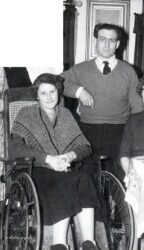
William Gordon (Bill) Reeves was born in Bridgend, Glamorgan on 24th October 1916 and he was brought up in Malpas, Shropshire. Nancy’s birth was registered on the 3rd August 1920 as Nancy Beatrice Page in Christchurch, Hampshire.
Bill got his first job as a teacher at Faringdon Secondary Modern School in Southampton Street two years before being called up at the start of WWII. He was sent to Bournemouth where he served in the Army Education Corps. There he met Nancy, also a teacher, who was helping out as a volunteer behind the counter at a Bournemouth church canteen. After the war, Nancy and Bill were married in Bournemouth in the later half of 1946. Bill then returned to his old job in Faringdon bringing his new wife with him. Nancy also joined the school staff as a music teacher. And they both set about becoming very active members of the community.
Nancy had always been an active member of the Girl Guides, in Bournemouth, but the movement had been allowed to elapse here during the war, so she started it up again. She ran both 1st Faringdon Guides and Brownies for many years. In 1952 she also founded the Ferndale School and was Headmistress there until she retired in 1979.
Bill started up Faringdon Dramatic Society in 1948. Both of them and their son Tim were very active members; Nancy for nearly 50 years! Her last performance was as Aunt Ada Doom in Cold Comfort Farm, July 1994.
Reference:
Nancy Reeves – Star of Stage and School (Faringdon Folly March 1992) – bill-nancy-reeves-ff1992.pdf
Russell Spinage
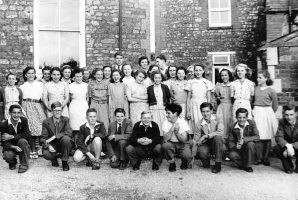
Russell Spinage was a local builder and he also had a funeral undertaker business near the school that used to be in Southampton Street and later he moved to the Old Railway Station. He was said to be a lovely man, and he started a youth club along with his sister Peggy in the 1940s and 50s. The youth club was first set up in Westbrook House, Gravel Walk and later moved to the old school house in Stanford Road. There they organised a great deal of activities and trips for the local teenagers. More … Faringdon Youth Clubs and also on the Faringdon Community Website.
Robert Tucker et al (Tucker & Sons Nurseries, Tucker Park)
In 1849 Robert Tucker established his garden nursery business just off the Stanford Road on a very small scale to begin with. The business will have consisted of the growing of vegetables and flowers but there are indications that trees were dealt with as there are one or two trees, notable a Giant Redwood, which must have been planted in his time. This can be linked with trees planted at the same time on large estates in the district.
[Mrs Sarah Tucker appears listed as a gardener with a nursery in the Wantage (Stanford) Road in 1863.]
At the time of the Coronation of Edward VII in 1901, the business had passed through the control of a second Robert Tucker (1842-) * into the hands of Robert H (1875-) and Walter Tucker (1876-1960) and had undoubtedly expanded considerably. The products by then will have included the growing of forest trees and hedge plants which supplied the large estates and farms in the area.
* [The 1881 Census return for the second Robert Tucker shows that he was born 1842 in Kingston, Somerset (ie. before his father Robert moved the family to Faringdon and set up the business in 1849). It also records that Robert (junior), now aged 39 was living in Faringdon, Berkshire as a nurseryman, seedsman & florist, employing 11 men and 2 boys. With wife Charlotte, he had 3 sons (2 named above + Martyn) and 3 daughters. They also had 2 young maid servants living with them.]
By the time of the crowning of George V in 1911, the Nurseries had greatly extended, as had the markets for its products. A retired foreman well remembers taking loads of trees to Caversham, near Reading by horse and cart at about this time.
[In 1929, W. Tucker was a committee member of the Faringdon Golf Club.]
When George VI was crowned in 1936, the business was under the partnership of Walter Tucker and his three sons – George, John (Robert John), and Mike. By this time further large additions had been made. the clientele was of nation-wide proportion and the varieties and quantities of plants, trees and shrubs were now very numerous. By this time the world renowned rose growing firm of George Prince of Longworth had been absorbed.
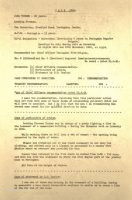 [Leading Fireman, John (Robert John) Tucker, 29 years old, from The Nurseries, Stanford Road, Faringdon was recommended for an award for devotion to duty during a German air-raid on Coventry on the nights of 14th and 15th November 1940. More…]
[Leading Fireman, John (Robert John) Tucker, 29 years old, from The Nurseries, Stanford Road, Faringdon was recommended for an award for devotion to duty during a German air-raid on Coventry on the nights of 14th and 15th November 1940. More…]
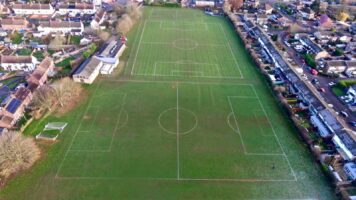 [In 1948, after World War II, when the ‘Recreation Ground’ on Park Road, once situated between the dairy/sawmill and the Hobwell footpath had become swallowed up by railway storage or timber yards, land on the opposite side of the road was given to the town by John’s father, Walter Tucker (1876-1960) to create Tucker Park. The new recreation ground (photo) also became the home for Faringdon Town Football Club.
[In 1948, after World War II, when the ‘Recreation Ground’ on Park Road, once situated between the dairy/sawmill and the Hobwell footpath had become swallowed up by railway storage or timber yards, land on the opposite side of the road was given to the town by John’s father, Walter Tucker (1876-1960) to create Tucker Park. The new recreation ground (photo) also became the home for Faringdon Town Football Club.
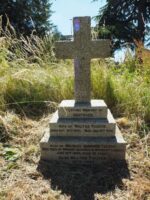 Walter gave the land as a lasting memorial to his son Michael Tucker who had been killed during the war in 1940 at Flanders **, aged 26. Mike left behind a widow Katherine Gwyneth Tucker, of Cardiff. He is listed as M. H. Tucker, a casualty of the war on the Faringdon War Memorial. He was buried in All Saints Churchyard, where his father and mother, Walter and Gertrude were added later. ** The article in The Folly 2 states that Mike Tucker was killed at Dunkirk, however his gravestone (photo) says Flanders.
Walter gave the land as a lasting memorial to his son Michael Tucker who had been killed during the war in 1940 at Flanders **, aged 26. Mike left behind a widow Katherine Gwyneth Tucker, of Cardiff. He is listed as M. H. Tucker, a casualty of the war on the Faringdon War Memorial. He was buried in All Saints Churchyard, where his father and mother, Walter and Gertrude were added later. ** The article in The Folly 2 states that Mike Tucker was killed at Dunkirk, however his gravestone (photo) says Flanders.
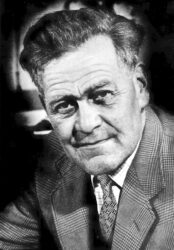 In 1953 when the young Queen Elizabeth was crowned, the firm of Tucker had undergone a major reorganisation. In 1951, it had become a limited liability company (R.Tucker and Sons Ltd) under the direction of Robert John Tucker and his wife, Millicent. [It later became Tucker’s Garden Centre and had establishments at Faringdon and Longworth.] Major reorganisation had taken place in reducing the number of nurseries from 6 to 2 with very large increases in the home nurseries. Production of trees, shrubs and plants exceed 10 million, floristry and vegetables were completely eliminated and customers numbered tens of thousands, occasional export orders and a large number of Government departments, County, Borough, Urban, Rural District and Parish Councils in all the countries of the United Kingdom. Production has become highly mechanised. A specimen garden was started to avoid the need for miles of walking which customers have to do on a large nursery. A start was made with rock plants by the construction of a rock garden under Mrs. M. M. E. Tucker.1
In 1953 when the young Queen Elizabeth was crowned, the firm of Tucker had undergone a major reorganisation. In 1951, it had become a limited liability company (R.Tucker and Sons Ltd) under the direction of Robert John Tucker and his wife, Millicent. [It later became Tucker’s Garden Centre and had establishments at Faringdon and Longworth.] Major reorganisation had taken place in reducing the number of nurseries from 6 to 2 with very large increases in the home nurseries. Production of trees, shrubs and plants exceed 10 million, floristry and vegetables were completely eliminated and customers numbered tens of thousands, occasional export orders and a large number of Government departments, County, Borough, Urban, Rural District and Parish Councils in all the countries of the United Kingdom. Production has become highly mechanised. A specimen garden was started to avoid the need for miles of walking which customers have to do on a large nursery. A start was made with rock plants by the construction of a rock garden under Mrs. M. M. E. Tucker.1
[Robert Tucker was a very active member of the Faringdon Rural District Council and became Chairman from 1958 to 1960.]
[A nurseryman all his life, John (Robert John) Tucker made his own significant contribution to virtually every element of community life in the town. He was Chairman of Faringdon Parish Council, 1958-60; Chairman of the old Faringdon Rural District Council; Chairman of the Faringdon Chamber of Trade; Chairman of the local Conservatives; President of the Faringdon Horticultural Society; and a Berkshire County Councillor. After relinquishing his interest in the family nursery business at Faringdon, John concentrated his efforts until retirement on his other horticultural venture, Princes Roses at Longworth. He died in a Witney nursing home in 1993. His older brother George, wife Millicent and their son Martin attended the funeral.]
During its 104 years of existence, the business has weathered several difficult periods due to the splitting of partnerships and reorganisation necessary, particularly two world wars which mean almost annihilation to a nursery business, when vast quantities of stock had to be burnt. Whilst the nature of the business alters with the passing of time, the old tradition of service, courteousness to the customer, competitive prices and fair dealing remained.
“The nursery was still in business when I visited it in the early 1980’s, a time in which there was a large boom in DIY superstores and garden centres. However, by the 1990’s it was abandoned and was left derelict for many years until taken over by large housing developments. I remember walking through the area many times and seeing the frames of abandoned green houses and piles of black plastic flower pots. A particularly memorable sight was a fairly large tree whose roots, in their bid for survival, had forced their way through the bottom of the tiny pot the young tree had originally been planted in and were firmly embedded in the surrounding ground.”
References:
- Extracted from the ‘The Tucker Tradition’ in the Faringdon Coronation Celebrations Programme (pdf). Sections shown inside square brackets [ ] have been fitted into the narrative from other sources.
- Faringdon Folly, August 1993 p7 – Death of a ‘friend of Faringdon’ – John Tucker.
Peter Wentworth (1940-2023)
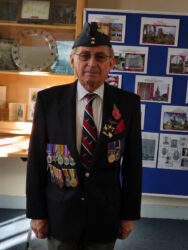
Peter was a well-known character around town, a true gentleman with a wonderful sense of humour.
It all started in … “1940 – the Battle of Britain was at it’s height and it was the noise of the RAF Hurricanes and Spitfires fighting in the skies above Britain that brought on my mother’s labour pains and I literally flew from the womb destined to join the Royal Air Force and stayed in for 37 years.”
During his time in the air force he was Loadmaster on 10 Squadron based out of RAF Brize Norton and later became Secretary of the 10 Squadron Association. He once said that for a time he had been crew on the Royal Flight and entertained the passengers with his magic tricks.
He was probably best known to most people for his guided heritage walks around Faringdon (dressed as Lord Berners) with comedy and magic tricks linked to the surroundings.
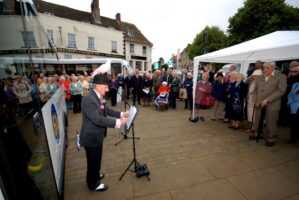
“Greetings Gentle Folk … If you can get a group of a minimum of 6 people then I will Walk the Bizarre Magical Walk with you….you will see 10 tricks linked to our stopping place finishing with a public hanging in the Archway of the Crown Coaching Inn!! And of course you will see all the 10 Lord Berners Silly Signs that have been rediscovered around our wonderful town of Faringdon”
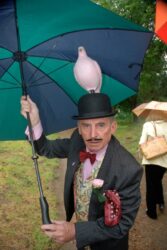
Peter was also a variety show entertainer and member of the British Music Hall Society. As a member of the Magic Circle, he was a magician raconteur and performer extraordinaire. Together with his impersonations of Lord Berners and Max Miller, his presence was often requested at numerous local events. Such varied events ranged from MCing at the Faringdon Arts Festival where he also had a magic booth, and at the ‘Mad Boy’s Tea Party’ held as part of Faringdon’s celebrations for Pride History Month, to opening the new kitchen and loos at Faringdon United Church.
He was also a valued member of the team with the ‘Friends of Faringdon Folly’, which supports the ‘Faringdon Folly Tower Trust’. If you have ever visited the tower during Halloween and been scared by the scary person in the lantern room, you will have met this majestic person.
Percival (Bill) White (1920-1996)
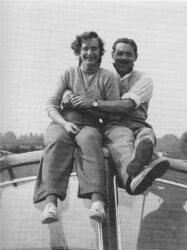
Percival Frank White was born in 1920. He had an elder brother, Henry, who had been born two years earlier. Their parents were Frank (1876-1952) and Ruth White who ran a hairdresser, tobacconist and stationery shop in the Corn Market at No. 7. They lived in Bleak House at the very end of Church Street.
The business had been started by Percival’s great grandfather, George (b. 1794). It was first recorded in London Street in 1844 and then in 1854 in Gloucester Street and he was listed as a hair cutter and perfumer. Then continued by his grandfather, Henry (1840-1877), but Henry died young, only a few months after his father, Frank was born. Presumably the business continued in the hands of Henry’s six older siblings and past on to Frank when he became old enough to take over.
Percival left school at the age of 14 years and joined his parents Frank and Ruth in the Corn Market shop. His uncle, Percival Henry White, was also a hairdresser in the business and he declared that there couldn’t be two people of the same name working there. He told young Percival that he would be called Bill and from then on this was the name that everyone knew him by. During the World War II, Bill joined the 5th Berkshire Home Guard Battalion as a despatch rider. The brothers Bill and Henry had probably taken over much of the running of the shop from their father Frank before the war and they ran it until 1987, when it became Haine & Smith’s opticians.
His wife Gwendoline Tanner was born at Cirencester in 1923 and Bill met her when his brother was courting her sister, Joyce. Bill, Henry and Joyce had been to a car rally and on the way back they had a slight accident with the car so it was decided to take Joyce back home first. Bill asked her if there was another one at home like her, Joyce replied that there was her young sister Gwen. Joyce and Gwen joined the Armed Forces during the war and, as the romance blossomed between her and Bill, Gwen applied to transfer to the W.R.N.S. based in Faringdon, The sisters were married on the same day at Faringdon in 1944, Joyce to Don Slingsby and Gwen to Bill. Bill liked to play tennis and helped to rejuvenate the Tennis Club. He was an enthusiastic supporter for a swimming pool in the Corn Exchange but unfortunately it failed to materialise. He also became interested in local politics, serving on the Council for about 30 years, being mayor for four years and becoming so well known that he was often called ‘Mr. Faringdon’. Bill died on 1st September 1996 aged 76 years.
Reference:
The Changing Faces of Faringdon and Surrounding Villages – Book 1 p63. By Rosemary Church, Jim Brown, Millie Bryan and Beryl Newman. Robert Boyd Publications 1999 – now out of print.
George Young
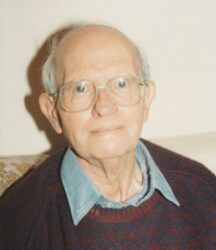 George was a teacher and a founding member of Faringdon Dramatic Society. Originally a Londoner, brought up in a hard-up East End dockworker’s family, his initial career was in the chemical industry. He first settled in Faringdon just after the war, where he had served as an RAF radar mechanic stationed in relatively peaceful southern India. It was his first teaching post, at the old Faringdon Secondary Modern School in Southampton Street, that brought him to Faringdon in 1949. He was later to become head of science, and stayed with the school until retirement, including the move to the new buildings on Fernham Road. Among those he taught was the famous entertainer Pam Ayres, who appeared in a few plays and later became a patron for the Dramatic Society. More… see the reference link below.
George was a teacher and a founding member of Faringdon Dramatic Society. Originally a Londoner, brought up in a hard-up East End dockworker’s family, his initial career was in the chemical industry. He first settled in Faringdon just after the war, where he had served as an RAF radar mechanic stationed in relatively peaceful southern India. It was his first teaching post, at the old Faringdon Secondary Modern School in Southampton Street, that brought him to Faringdon in 1949. He was later to become head of science, and stayed with the school until retirement, including the move to the new buildings on Fernham Road. Among those he taught was the famous entertainer Pam Ayres, who appeared in a few plays and later became a patron for the Dramatic Society. More… see the reference link below.
Reference:
Faringdon Folly, November 1993 p9 – George Young. Download george-young-ff1993.pdf.
Researched and compiled by Ian Lee, November 2021.
